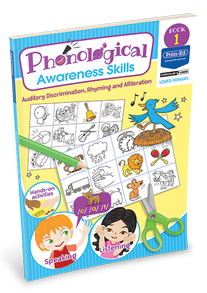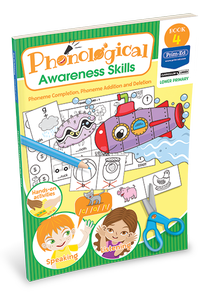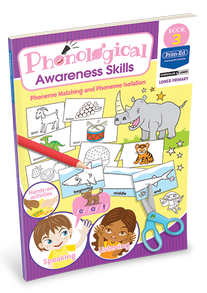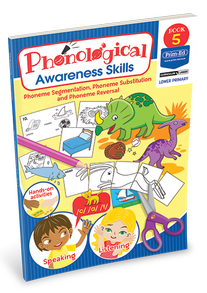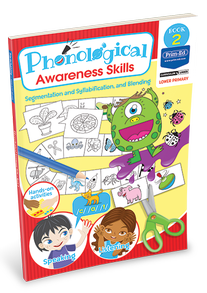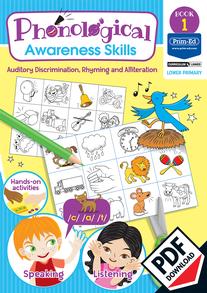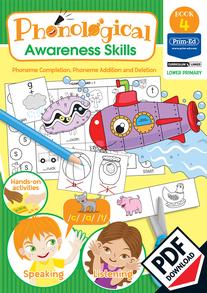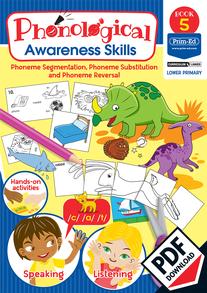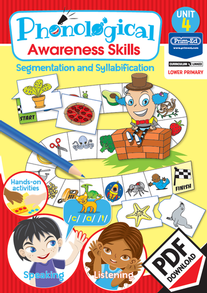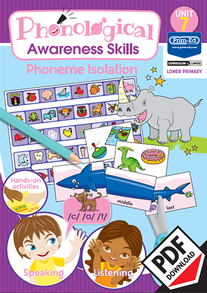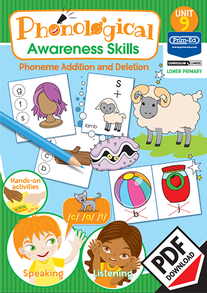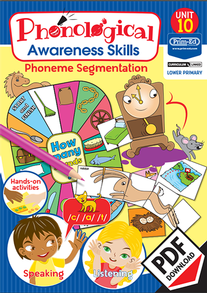-
0
Your cart is currently empty.
-
0
Your cart is currently empty.
Phonological Awareness Skills
Phonological awareness skills are the foundation of spelling, reading and writing. They involve being aware of the individual sounds in words, and how these sounds can be put together to form words.
Many parents and educators find phonological or phonemic awareness quite confusing. Prim-Ed’s must-have Phonological Awareness Skills series will take the confusion out of phonological awareness and equip young children and pupils with the skills needed to conquer the world of words.
Download a sample of Phonological Awareness Skills
What is phonological awareness?
Phonological awareness is the ability to hear, identify and manipulate individual sounds in words. It is one of the best predictors of writing and reading success, as it helps children understand how words are made up of smaller units of sound.
Being able to understand the sound structure of words is important for reading skills because it allows children to break down unfamiliar words into individual phonemes (sounds) so that they can work out the word’s pronunciation.
Importance of phonological awareness
The development of phonological awareness skills lays the foundation for future reading and English language success. Research shows that children who have a strong grasp of phonics are more likely to read accurately and fluently.
It is also important for writing, as it helps children spell words correctly by enabling them to hear the different phonemes in a word and then write them down accurately. They also find it easier to learn how to spell new words.
Examples of phonological awareness skills
There is a range of phonological awareness skills, but some examples are being able to segment words into individual phonemes, identifying the beginning and end sounds in a word, and blending phonemes together to make a word.
Some examples of phonological awareness skills include:
- recognising and producing rhyming words
- breaking words down into syllables
- segmenting and blending speech sounds
- identifying onset (beginning sounds) and rime (end sounds) in words.
What is phonemic awareness?
Phonemic awareness is a specific type of phonological awareness that focuses on the individual sounds in words.
Phonological or phonemic awareness refers to the ability to hear, identify and manipulate the individual phonemes in spoken words.
Phonemic awareness is an important precursor to reading and writing, as it helps children understand how spoken words are made up of smaller units of sound.
Phonemic awareness is essential for learning to read and spell.
Examples of phonemic awareness skills
Some examples of phonemic awareness skills include:
- recognising that words are made up of different speech sounds
- being able to hear and say the different sounds in a word
- being able to blend together different sounds to make a word
- being able to break down a word into its individual phonemes
The Phonological Awareness Skills Series
This series of five comprehensive books covers all the basics for young pupils (from four years of age) but is also useful for older pupils who are struggling with learning phonics and spelling. The series is designed for teachers to incorporate into their spelling and phonics lessons.
The twelve skills presented in developmental order over the five books include:
- Book 1: Auditory Discrimination, Rhyming and Alliteration
- Book 2: Segmentation and Syllabification, and Blending
- Book 3: Phoneme Matching and Phoneme Isolation
- Book 4: Phoneme Completion, and Phoneme Addition and Deletion
- Book 5: Phoneme Segmentation, Phoneme Substitution and Phoneme Reversal
The last seven skills relate to phoneme manipulation.
Features of the Phonological Awareness Skills Series
As all phonics skills are learnt orally, the series has been carefully designed to support educators with lesson-break style games and fun activities in the classroom.
The series of books includes:
- Teacher background information - provides teachers with information on the phonological awareness skill, why it is important and what to look for when assessing children’s understanding.
- Games and activities - a selection of fun and engaging games and activities to help children learn the relationships between speech sounds.
- Instructions - clear teaching instructions on how to carry out each game and activity, with tips for educators on how to get the most out of each one. Assessment sheets - these can be used as a guide to assess each child’s understanding of the phonological skill.
- Assessments - a range of assessments to help educators track children’s progress in phonics recognition.
- Phoneme and phonics worksheets - additional support worksheets if applicable.
- External resources - all materials for each activity, literature links and suggested websites for games are also included where applicable.
- Photocopiable resources - a range of ready-to-use photocopiable phonics resources that can be used in the classroom.
There are also full-colour individual downloadable units for each skill, available in PDF format:
- Segmentation and Syllabification Unit
- Phoneme Isolation Digital Unit
- Phoneme Completion Digital Unit
- Phoneme Addition and Deletion Digital Unit
- Phoneme Segmentation Unit
- Phoneme Substitution Unit
- Phoneme Reversal Unit
Teaching strategies for educators
There are many different ways to teach phonological or phonemic awareness in the classroom.
The first step is learning about phonemes. Phonemes are the smallest unit of speech that distinguish one word (or sound segment) from another. In English, there are 44 phonemes. Each letter of the alphabet represents one or more phonemes.
Teachers can help pupils become aware of phonemes by having them listen to a word and clap or snap their fingers each time they hear a different sound. For example, the word ‘bat’ could be clapped as /b-a-t/.
Pupils can also practise segmenting words into individual phonemes. To do this, they say the word slowly and break it down into smaller parts, sounding out each phoneme one at a time. For example, the word ‘stop’ could be segmented as /s-t-o-p/.
Teaching phonological awareness in the classroom
In this series, skills are developed through fun, hands-on games and activities for whole-class, small group and pair work, phonics worksheets with full instructions (including the actual words to say, if required).
Phonological awareness games and phonemic awareness activities are perfect for learning stations and station teaching. They can also be a great tool for motivating young learners, helping to develop their grasp on the topic or for those who need more practice before moving on in their lessons.
All games and activity resources, supporting phonics worksheets, differentiation ideas, formative and summative assessments and answers are provided.
Phonics worksheets and PDF resources to support the Language Curriculum
Phonics worksheets and PDF resources can be a great way for children to practise identifying the phonemes in words. The resources can also be used to help children learn how to spell words correctly through language play and phonics worksheets.
This series is an excellent resource to help teachers address the learning outcomes of the new Irish Primary Language Curriculum which include:
- Phonics, word recognition and word study
- Phonological and phonemic awareness
For Stages 1 and 2, the Language Curriculum states that pupils should be able to ‘play with and recognise sounds such as syllables, rhyme, onset-rime and phonemes in spoken words’. This series emphasises the oral element in understanding phonics.
This means that all pupils will benefit from phonics teaching and learning, whether they are learning phonics through Irish or English.
Frequently asked questions
How does phonological awareness help with decoding?
Phonological awareness is an early critical skill for children to develop as it helps them identify and manipulate sounds in spoken language. This skill is important for learning to read because it helps children break down words into their individual phonemes (sounds). Once children understand how phonemes work, they can use this knowledge to decode unfamiliar words.
What is involved in teaching phonemic awareness?
There are a number of different activities that you can use to help teach phonemic awareness skills. One popular activity is ‘sound sorting’. In this activity, children listen to a word and then sort it into the correct column according to the sound that they hear at the beginning, middle or end of the word.
Other tools that teachers can use to help develop these skills include:
- Phonemic or phonics flashcards are a great way to get children started by introducing the letters and sounds in words.
- Sound files accompanying books, allowing children to listen to the phonemes and words used in the games and activities.
Are there signs a child is struggling with phonological awareness?
If a child is having difficulty with phonological awareness, there may be certain signs that you can look out for. One sign is if the child has trouble with basic word skills, such as being able to read and write simple words. Another sign is if the child has difficulty learning new words.
What can parents do to help at home?
There are a few things that parents can do to help their children develop phonological understanding at home. One is to read rhyming books and stories together and have the child repeat the words after you.
You can also play simple word games, like ‘I Spy’ or ‘Hangman’. It can also be helpful for parents to listen to their child read out loud, and point out the different phonemes in the words.
